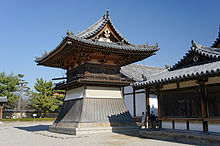Shōrō

The Shōrō of the Hōryū-ji
The Shōrō ( Japanese 鐘楼 , dt. " Bell tower " from Chinese 鐘樓 / 钟楼 , Pinyin zhōnglóu ), also read Shurō or Kanetsuki-dō ( 鐘 突 堂 , "Bell-ringing hall") and Tsurigane-dō ( 釣 鐘 堂 , "iron bell hall" ), is part of traditional Buddhist temple complexes in Japan and was also adopted in parts of Shinto .
With its dimensions of 3 × 2 Ken , it is located in the classic arrangement of Japanese temples west of Kyōzō . In the further course of the history of Japanese temple architecture, however, it broke away from its traditional, strictly symmetrical place, and followed the, also topographically, different requirements of the respective Buddhist school. Its use for religious purposes of devotion differs depending on the Buddhist school.
literature
- Robert E. Fisher: Buddhist Art and Architecture . Thames and Hudson, 1993, ISBN 0-500-20265-6
- Kazuo Nishi, Kazuo Hozumi: What is Japanese Architecture . Kodansha International 1985, ISBN 0-87011-711-4
- Alexander Soper and Alexander Coburn, The Evolution of Buddhist Architecture in Japan . Hacker 1979, ISBN 0878171967
See also
- Korō (drum tower)
Web links
Commons : Bell Towers in Japan - Collection of Images, Videos and Audio Files
Individual evidence
- ^ The Art and Architecture of Japan, Robert Treat Paine and Alexander Soper, Yale University Press, 1981, ISBN 0-300-05333-9 , p. 270